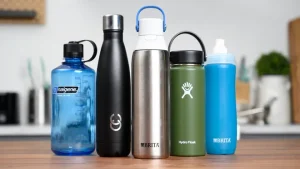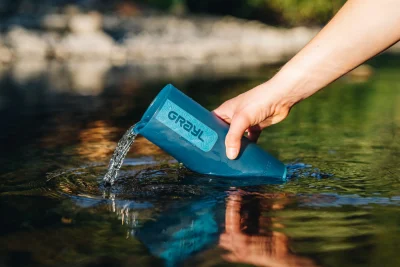Water bottle measurements play a crucial role in our daily lives, guiding us through the world of hydration with precision and practicality. Whether you’re an athlete tracking your fluid intake, a backpacker optimizing pack space, or simply someone seeking to stay adequately hydrated throughout the day, understanding the dimensions of your water bottle can make a significant difference.
In this article of water bottle measurements, we delve into the importance of these seemingly simple numbers and how they impact our hydration routines and adventures. Join us on a journey to unravel the dimensions of your trusty hydration companion.
Water bottle measurements

Water bottles come in a variety of sizes, but the most common sizes are:
- 16.9 fluid ounces (500 milliliters): This is the standard size of a water bottle. It is a good size for carrying around with you throughout the day.
- 32 fluid ounces (946 milliliters): This is a larger size that is good for hiking, camping, or other activities where you will be away from a water source for an extended period of time.
- 64 fluid ounces (1.89 liters): This is a very large size that is good for people who need to drink a lot of water each day.
- 128 fluid ounces (3.78 liters): This is a super large size that is good for people who are training for a marathon or other endurance event.
The dimensions of water bottles also vary depending on the size. The standard 16.9 fluid ounce water bottle measures about 2.5 inches in diameter and 8 inches tall. The 32 fluid ounce water bottle measures about 3 inches in diameter and 10 inches tall. The 64 fluid ounce water bottle measures about 4 inches in diameter and 12 inches tall. The 128 fluid ounce water bottle measures about 5 inches in diameter and 14 inches tall.
Of course, there are many other sizes and shapes of water bottles available. Some water bottles are designed to be compact and lightweight, while others are designed to be durable and insulated. Ultimately, the best water bottle for you will depend on your individual needs and preferences.
How tall is a typical water bottle?
A typical water bottle’s height can vary depending on the type and size of the bottle. However, I can provide you with some common dimensions for different types of water bottles:
- Standard Plastic Water Bottle: These are often around 8 to 9 inches (20 to 23 centimeters) in height. They typically hold around 16.9 fluid ounces (500 milliliters) of water.
- Sports or Fitness Water Bottle: These are typically taller and narrower than standard plastic bottles. They can range from 9 to 11 inches (23 to 28 centimeters) in height and may hold between 16 to 32 fluid ounces (500 to 946 milliliters) of water.
- Reusable Metal Water Bottle: These bottles come in various sizes, but a common size is around 9 to 10 inches (23 to 25 centimeters) in height and can hold 16 to 24 fluid ounces (473 to 710 milliliters) of water.
- Large Water Jug: These are much larger and can be up to 12 to 15 inches (30 to 38 centimeters) in height, holding between 32 to 64 fluid ounces (946 milliliters to 1.9 liters) of water or more.
Keep in mind that these are general dimensions and can vary based on the brand, design, and intended use of the water bottle. Some bottles are designed to be more compact for easy portability, while others are larger for use during physical activities or for longer periods without needing a refill.
Additionally, there are various non-standard and specialty water bottles with unique shapes and sizes available in the market.
What is the capacity of a standard water bottle in milliliters?
The capacity of a standard water bottle is typically 500 milliliters (ml). This is a common size for single-serving water bottles that you might purchase in a convenience store or use for personal hydration.
The 500 ml capacity is often chosen because it’s a convenient amount for people to drink in one sitting, and it’s also easy to carry. It’s roughly equivalent to about 16.9 fluid ounces in the United States, making it a standard size for bottled water in that country.
However, it’s important to note that the term “standard water bottle” can vary depending on location and manufacturer. In some regions or for certain brands, you might find water bottles with different capacities, such as 330 ml or 750 ml.
It’s always a good idea to check the label or packaging of a specific water bottle to know its exact capacity, as it can vary based on the brand and type of bottle you’re using.
How wide is a common water bottle?

The width of a common water bottle can vary depending on the specific design and brand. However, a standard water bottle typically has a diameter of around 2.7 to 3.0 inches (approximately 6.9 to 7.6 centimeters). This is a general range, and there can be slight variations, especially in specialty bottles or those designed for specific purposes.
Keep in mind that different brands and types of water bottles may have slightly different dimensions, so it’s a good idea to check the product specifications or the label of a particular bottle if you need precise measurements. Additionally, the shape of the bottle, such as cylindrical, tapered, or square, can also affect its width and overall design.
How thick is the plastic of a typical water bottle?
The thickness of the plastic used in a typical water bottle can vary depending on the brand, type, and manufacturing process. Generally, water bottles are made from polyethylene terephthalate (PET) plastic, which is known for its lightweight and durable qualities.
The thickness of PET plastic used for water bottles is typically in the range of 0.15 to 0.35 millimeters (mm), or about 150 to 350 micrometers.
The exact thickness can vary between different bottle manufacturers and the intended use of the bottle. Single-use disposable water bottles, for example, tend to have thinner walls, while reusable or more durable water bottles may have thicker walls to increase their longevity.
It’s important to note that the plastic used in water bottles is designed to be strong enough to hold the liquid and withstand typical handling but thin enough to keep the bottle lightweight and cost-effective to produce. If you have specific concerns about the thickness or sustainability of a water bottle, it’s a good idea to check the product information provided by the manufacturer.
How heavy is an empty water bottle in grams?
The weight of an empty water bottle can vary widely depending on its size, design, and the type of plastic used. However, a common range for the weight of an empty disposable plastic water bottle is approximately 10 to 20 grams (g).
Again, it’s important to note that the actual weight can vary based on factors such as the bottle’s capacity, thickness of the plastic, and any additional features or materials (such as labels, caps, or seals) that may be present on the bottle.
For example, smaller water bottles with capacities of 250 ml may weigh less than larger bottles with capacities of 500 ml or more. Similarly, bottles made with thicker plastic may be heavier than those with thinner walls.
If you have a specific water bottle in mind, you can usually find the weight information on the packaging or product specifications provided by the manufacturer.
How long is the neck of a typical water bottle?
The length of the neck of a typical water bottle can vary depending on the design and purpose of the bottle. However, I can provide you with a general idea of the length of a standard water bottle neck.
Most commercially available water bottles, whether they are made of plastic, glass, or other materials, have a neck that is typically around 1 to 2 inches (2.54 to 5.08 centimeters) in length. This measurement includes the threaded portion of the neck where the bottle cap or closure screws onto.
The length of the neck is designed to serve several functions:
- Sealing: The neck of the bottle needs to be long enough to ensure a tight seal when the cap or closure is screwed on. This prevents leakage and keeps the contents of the bottle secure.
- Ease of Use: A longer neck makes it easier to grip and twist the cap on and off, which is important for user convenience.
- Pouring: The length of the neck also affects how the liquid flows out of the bottle when you pour it. A longer neck can provide better control over the pour, reducing the chances of spills.
- Attachment for Accessories: Some water bottles have additional features or accessories that attach to the neck, such as straws or filtration systems. The length of the neck can accommodate these accessories.
It’s worth noting that specialty bottles designed for specific purposes, such as sports bottles or baby bottles, may have different neck lengths to suit their intended use.
Overall, the length of a water bottle’s neck is a carefully considered design feature that balances functionality, convenience, and the intended use of the bottle.

How deep is the base of a regular water bottle?
The depth or height of the base of a regular water bottle can vary depending on the design and size of the bottle. However, I can provide you with a general idea of the typical depth of the base for a standard water bottle.
In most standard water bottles, the base or bottom of the bottle is typically around 2 to 3 inches (5.08 to 7.62 centimeters) in height. This measurement is from the lowest point of the base to the beginning of the curved or cylindrical body of the bottle.
The depth of the base is an important design feature for several reasons:
- Stability: The base needs to be deep enough to provide stability to the bottle when it’s standing upright. A deeper base helps prevent the bottle from tipping over easily.
- Capacity: The depth of the base, combined with the shape of the bottle, determines the overall capacity or volume of the bottle. A deeper base allows for a larger volume of liquid to be stored in the bottle.
- Structural Integrity: The depth of the base is also designed to provide structural integrity and support for the weight of the liquid and the bottle itself.
It’s important to note that the specific dimensions of the base can vary among different brands and types of water bottles, so you may find some variation in the depth of the base when comparing different bottles.
Additionally, specialty bottles designed for specific purposes, such as sports bottles or travel bottles, may have unique base designs to cater to their intended use.
How wide is the mouth of a standard water bottle?
The width of the mouth of a standard water bottle can vary depending on the specific design and brand of the bottle. However, I can provide some general information to help you understand the common variations:
- Narrow Mouth: Many standard water bottles have a narrow mouth, typically measuring around 1 inch (2.54 centimeters) in diameter. Bottles with narrow mouths are often preferred for drinking on the go because they allow for controlled sipping and minimize the risk of spilling water.
- Wide Mouth: Some water bottles have a wider mouth, which can measure around 2 to 2.5 inches (5.08 to 6.35 centimeters) in diameter. Wide-mouth bottles are often used for activities where you may need to refill the bottle quickly or add ice cubes easily. They are also suitable for those who prefer gulping water quickly.
- Extra-Wide Mouth: There are also water bottles with even wider mouths, exceeding 2.5 inches in diameter. These bottles are designed for specific purposes, such as mixing protein shakes or adding fruits and ice for infusions. They provide easy access for pouring, mixing, and cleaning.
It’s important to note that the exact width of the mouth can vary between different brands and models of water bottles.
To find the specific width of the mouth for a particular bottle, you should refer to the product specifications provided by the manufacturer. Additionally, the choice of mouth width is often a matter of personal preference and intended use, so you can select the one that best suits your needs.
Conclusion
With the information on this page, you can learn about water bottle measurements. The width of the mouth of a standard water bottle varies depending on its design and intended use.
Common measurements include a narrow mouth at around 1 inch in diameter for controlled sipping, a wide mouth at 2 to 2.5 inches for quick refilling and ice cube access, and extra-wide mouths exceeding 2.5 inches for specific purposes like mixing or infusions.
The precise mouth width can differ among brands and models, so it’s essential to check the product specifications for accuracy. Ultimately, the choice of mouth width depends on individual preferences and the intended use of the water bottle.


